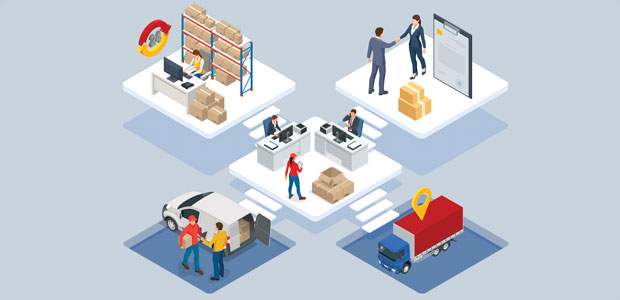
The difference between inbound and outbound logistics
Inbound and outbound logistics, often used interchangeably, are very different processes that serve other purposes in the supply chain. Understanding the differences between inbound and outbound logistics can help you streamline your supply chain, reduce costs and improve customer satisfaction.
What is inbound logistics?
Inbound logistics involves getting goods from your supplier to your facility. Inbound logistics, usually managed by a third party, will handle all aspects of the transportation, storage and delivery of incoming goods.
Inbound logistics is the first step in the supply chain, and it's a crucial part of the supply chain because it sets up everything that happens afterwards.
Inbound logistics is the part of the supply chain that deals with transporting, storing, and delivering incoming goods.
What is outbound logistics?
Outbound logistics is the part of the supply chain that deals with taking finished products from a facility and delivering them to distributors or consumers.
Outbound logistics involves:
- Make sure everything is ready for shipping
- Picking and packing the goods
- Transporting them to their destination
- Unloading, storing and distributing goods
A third party usually manages the inbound logistics process, but the company itself usually operates the outbound logistics process.
Inbound logistics is more complex because it involves moving goods from one location to another. On the other hand, outbound logistics is usually simpler because it involves moving products from the manufacturing facility to either a retailer or a customer. For example, suppose you're producing shoes in China and shipping them to Canada for sale. In that case, your outbound logistics will be relatively straightforward compared with what goes on behind the scenes when you receive an order from a customer in New York City and ship it out.
The two processes are closely connected and dependent on each other to ensure an efficient supply chain.
Inbound logistics is the act of receiving and storing goods, while outbound logistics is the process of shipping those same products. While these processes are closely connected and dependent on each other to ensure an efficient supply chain, they differ in many ways.
Inbound logistics focuses on collecting orders from customers, verifying their accuracy and authenticity (i.e., that they're not fraudulent), and then sending them off to a warehouse where they can be stored until they're ready for shipment. Meanwhile, outbound logistics focuses on moving items from one part of your organization to another; this might mean moving finished products offsite or shipping raw materials back into production if you're manufacturing or creating new products.
The two processes are connected—you need both inbound and outbound logistics to complete your supply chain—but there are differences between them when considering which system works best for your business.
Understanding inbound vs outbound logistics can help you improve your business
Inbound logistics bring merchandise into a company, including all the processes involved in getting a product from its origin to its final destination. The term "inbound" refers to the flow of goods, not people.
Inbound logistics focuses on creating systems for moving products from suppliers to warehouses and distribution centres, where they can be shipped out or stored until they're ready for sale. Inbound logistics covers everything from cross-docking orders before they reach customers back at home base. Like Walmart does with online orders when they arrive at one of their distribution centres, as well as managing returns and other back-and-forth exchanges between companies without ever involving shoppers at retail stores like Target or Best Buy.
Outbound logistics focus on getting finished goods into marketplaces by using packaging materials such as boxes, labels or pallets; transportation methods such as trucks or railroads; and warehousing practices like inventory management software solutions (WMS).
We hope this article has helped you better understand inbound vs outbound logistics and how they work together to create a more efficient supply chain. If you're looking for more information about the logistics process, check out our blog post on how to best manage it in your business!
For more startup news, check out the other articles on the website, and subscribe to the magazine for free. Listen to The Cereal Entrepreneur podcast for more interviews with entrepreneurs and big-hitters in the startup ecosystem.

